|
 |
Curtis Varnell has a Masters Degree from Arkansas Tech University in Science Education. He has over twenty years of experience in teaching at the high school level and has carried out graduate level research with NASA, USDA, and the Arkansas Nuclear one. He has received a Fulbright Teacher Scholarship to study in Japan, a Woodrow Wilson Foundation Scholarship for the study of Tropical Environments in Costa Rica, and a Woodrow Wilson Fellowship for graduate environmental studies at Princeton University. |
|
Curtis is working on a PhD in ENDY with emphasis in hydrology. His research involves the variability of obtaining potable water from underground coal mines. He, Keri Walker, and his advisor, Dr. Van Brahana, are currently involved in determining the water quality, quantity, and availability in the coal mines near Greenwood, Arkansas. |
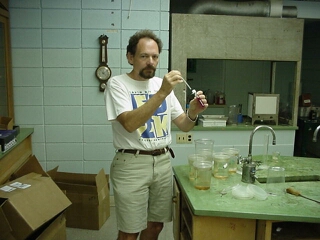
|
|

|
Stephan Pollard is studying the stimulation of recycling behaviors in multi-unit dwellings. Science is increasingly concerned with environmental issues, not the least of which are resource conservation and the mitigation of problems associated with landfills and solid waste disposal. Recycling, an important part of the solution to these challenges has in recent years been made easier by residential curbside pickups. Curbside recycling programs designed for single-family dwellings are arguably the dominant form of recycling in the U.S. But when it comes to multi-unit dwellings programs are few and undeveloped. Recycling as it relates to multi-unit dwellings is little understood. |
| Environmental education, persuasive communications, prompting, incentive, removal of barriers, public commitment, goal setting, social influence, and feedback approaches to increasing the level of recycling have been the subject of many applied behavioral studies. Of the experimental behavior interventions few have demonstrated response maintenance once discontinued. Feedback, though notably successful in other behavior-change experiments, has been relatively unexplored in recycling research. Stephan Pollards research focuses on longer experimental interventions (and longer measurements of response) that attempt to increase the level of recycling in multi-unit dwellings using both the feedback and removal of barriers techniques. Attention is given to a 28 unit and 400 unit apartment complex in the vicinity of a medium-large size state university. |

|
|
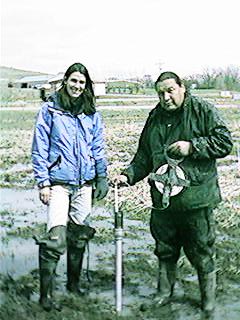
Shelley McGinnis and Santee Sioux environmental
technician obtain water levels from monitoring wells.
|
Shelley McGinnis completed a Master’s degree in Anthropology at the University of Arkansas in 1998 and is currently pursuing a Ph.D. in the Environmental Dynamics Program. Her research interests include tribal water quality and environmental justice. The primary focus of Shelley’s dissertation is surface-water and ground-water quality within the Omaha and Santee Sioux Nations of eastern Nebraska. Her research will compare water-quality data from these reservations to existing regional, state and national water-quality data in order to determine if these differences are statistically significant. |
| Shelley McGinnis’ project will also include a case study of the Santee Sioux Reservation to explore whether factors such as well construction, maintenance, and land use patterns influence water quality. In addition, county level income and education data for the State of Nebraska will be analyzed to determine what relationship these factors have to domestic well water quality throughout different parts of the state. Finally, digital land use data, based on 1992 Landsat Thematic Mapper mosaics, will be utilized to determine the impact of different types of land cover on surface-water quality in selected watersheds within both reservations. Studies such as this are currently needed to help tribes and other agencies involved with American Indians identify environmental priorities and develop effective policy. |
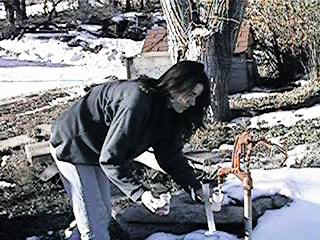
Shelley is shown here collecting a domestic well
water sample from the Santee Sioux Reservation. |
|
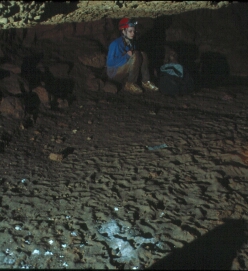
Blaine analyzing prehistoric black bear (Ursus americanus) tracks in a remote area of an Ozark cave. Caver Amy McCann in background. Photo by Jim Kaufmann. |
Blaine Schubert received his BA (1994) in Earth Science and Anthropology at Central Missouri State University (Warrensburg) and his MS (1997) in Quaternary Studies at Northern Arizona University (Flagstaff). His MS project focused on the paleoecology of a terminal Pleistocene mammalian fauna from a central Ozark cave. From 1998-2001 he was a Research Associate in Geology at the Illinois State Museum (ISM). During his time at the ISM he worked mostly with Pleistocene faunas from Ozark caves. |
| Blaineís research interests focus on the paleoecology and community evolution of reptiles and mammals over the past 5 million years. Of particular interest is how environmental changes affect the ecology, distribution, and evolution of mammals. He is now working under Dr. Peter Ungar, learning the techniques of dental microwear analysis. Blaineís Ph.D. project will focus on the dental microwear of the mammals from Makapansgat Cave in South Africa. This analysis is part of a larger interdisciplinary project (directed by Dr. Matt Sponheimer), which also includes isotopic and ecomophology analyses of the Makapansgat mammals. The primary goal of the project is to reconstruct the paleoecology of the early hominin Australopithecus africanus. |
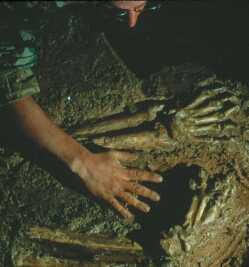
Articulated giant short-faced bear (Arctodus simus)remains in an Ozark cave. Caver Andy Free compares his ďpawĒ to the bearís. Photo by Jim Kaufma |
|
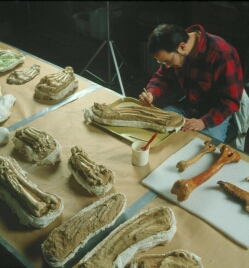
Blaine excavating giant short-faced bear remains in the preparation laboratory at the Illinois State Museum. Photo by Gary Andrashko, ISM. |
Current projects that are near completion include 1) a book on North American cave paleontology (edited by Blaine, Dr. Jim Mead and Dr. Russell Graham), 2) a manuscript on a partially articulated giant short-faced bear (Arctodus simus) from an Ozark Cave (with Jim Kaufmann, a fellow student), and 3) a paper on the paleoecology of Jeffersonís ground sloth (Megalonyx jeffersoni) and elk-moose (Cervalces scotti) at the terminal Pleistocene (with Dr. Russ Graham and Dr. Greg McDonald.

Comparison of giant short-faced bear (Arctodus simus) with three types of living North American bears. From left to right, Alaskan brown bear (Ursus arctos), grizzly bear (also Ursus arctos), and black bear (Ursus americanus). Drawing by natural history artist Carl Dennis Buell. |
|
Subsistence-Settlement Patterns on the Alaska Peninsula Pacific Coast
A Dissertation Proposal Submitted by Patricia McClenahan
The Pacific coast of the central Alaska Peninsula is a rugged, precipitous, environmentally dynamic, but highly productive region. The sharp physiographic contrast between the gentle shores of the Bering Sea and the rigorous fjiorded shoreline of the Pacific coast of Alaska, and contrasts in ecosystems between the upper and central Alaska Peninsula necessitates the creation of new subsistence-settlement system models for the Pacific coast area in order to accurately and effectively portray human use of this portion of the coast through time. This study uses the archaeological, ethnographic, and environmental record bearing on the lifeways of the inhabitants of the Central Alaska Peninsula, Pacific coastal region during late prehistoric through modern times to create and test a GIS-based predictive model to locate previously unrecorded habitation sites in this little-studied region. |
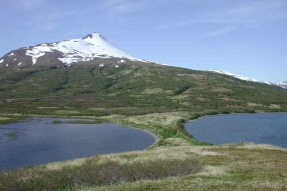
View of prehistoric/historic Fish Village on Ruth River. |
|

View of village below Mt. Becharof in western Portage Bay. |
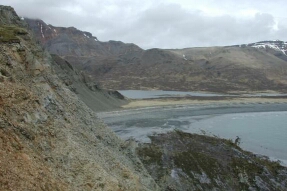
View of prehistoric/historic village of Kanatak from west Portage |
|

|
Greg Vogel participated in an archaeological project at the Norman Site (34WG02) in eastern Oklahoma. The Norman Site is a Caddoan "civic ceremonial center" -- it is a complex of earthen mounds constructed about 1000 years ago that appears to have served as a political and ritual center for a large population. The site was inundated by water with the construction of the Grand Lake reservoir. Archaeological projects in the 1930s and 1940s partially excavated the site, and several of the mounds were used for fill for a roadway across the reservoir. Currently, only the remnants of one mound is left, projecting above the Grand Lake as an island. This mound is being severely eroded by waves from the Grand Lake, and the Corps of Engineers (with jurisdiction over the reservoir) is planning to stabilize the mound by covering it in boulders. Prior to this stabilization effort, we were called in to document what was left of the mound and record the wave-cut profile. |
| As you can see from the profile images, the mound remnant is quite large, but it represents about 1/4 or less of the original extent of the mound. This mound is a platform mound -- it contains no burials or artifacts to speak of, but was constructed in a complex series of stages that included extensive re-working of the mound and the construction of buildings on several stages. Our work shows the details of much of this construction. Marvin Kay led the project, and it will serve as the basis of Greg Vogelís ENDY dissertation. |
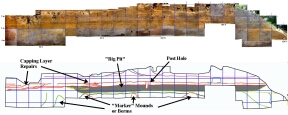
Click Image for larger view.
|
|

My advisor (Dr.Boss S.K.) and I in one of lake surveys using a University of Arkansas Research Vessel, R/V Ozark Traveler, an 8-m pontoon boat maintained by the Department of Geosciences for limnological research. |
Ben Kisila Odhiambo
PhD Dissertation Title - Sedimentation, watershed physiography and historical water quality of reservoirs: Case studies from NW Arkansas using Geographical Information Systems (GIS) approach I am interested in researching the behavior of contaminants and nutrients in the context of natural aquatic systems; using tools such as hydrochemical water analysis, transient and steady state tracers, particle fluxes and sedimentation rates, multivariate statistics and Geographical Information Systems (GIS).
|
| Of particular interest are analyses of surface water site-specific contaminant sources as well as broader contaminant issues associated with long-range atmospheric transports; eutrophication of lakes and reservoirs associated with fluxes of nutrients and increase of productivity in surface waters; watershed geomorphological analysis; use of geophysical methods in sedimentation research such as multifrequency echo-sounding systems to estimate sedimentation rates, sediment thicknesses and stratigraphical sequences in lakes and reservoirs; ground water quality and contamination; and the interaction between surface and ground waters, i.e., using major ions and stable isotopes in establishing mixing trends and contamination. |
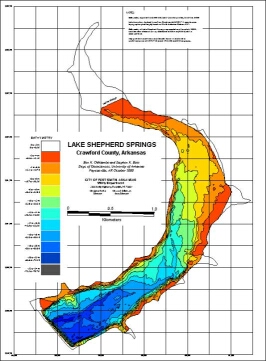
A sample of survey products: A detailed bathymetry map of Lake Shepherd Springs developed from survey data using GIS (Map info)
|
|
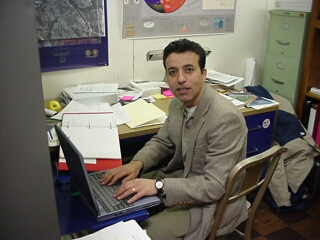
|
Salem Thawaba is a first year ENDY student from Anabta, West Bank, Palestine. He has an undergraduate degree in Architectural Engineering from Beir Zeit University and a Masters in Regional Planning and Urbanism from the Oslo School of Architecture. Past experience includes GIS coordinator for the Computer and Communication System Company of Jordan, worked with an engineering consultant firm in Ramalla, and served the Palestinian Ministry of Planning and International Cooperation in developing a plan for Landscape Assessment for the West Bank. He also served as a member of the team developing the Emergency National Resources Protection Plan for Palestine and also the regional plan for the West Bank. |
|
Salemís focus will involve the study of sustainable development and natural resource management of the Wadi Faría area of Palestine. Eventual plans are to develop a program to reduce the amount of water pollution entering the region from surrounding urban areas, develop successful agricultural practices for farmers, create public awareness about environmental issues, and to protect the archeological sites found there.
|
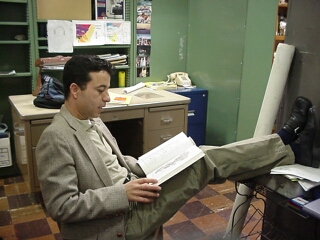
|



